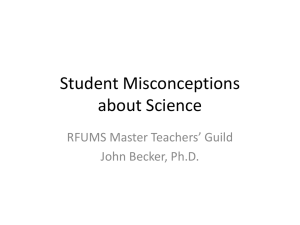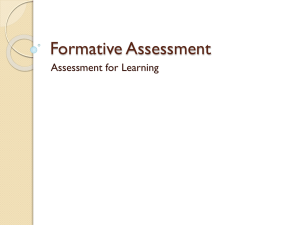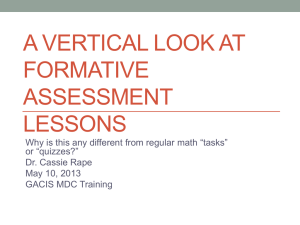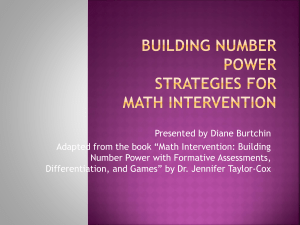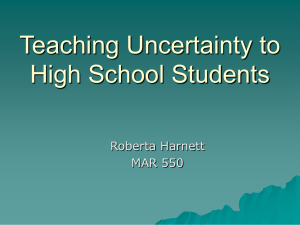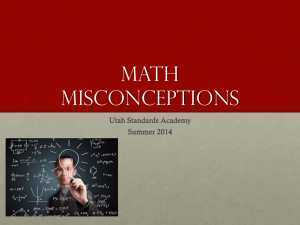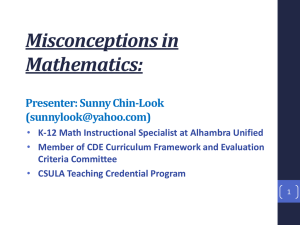Measurement in Grades 3-5
advertisement
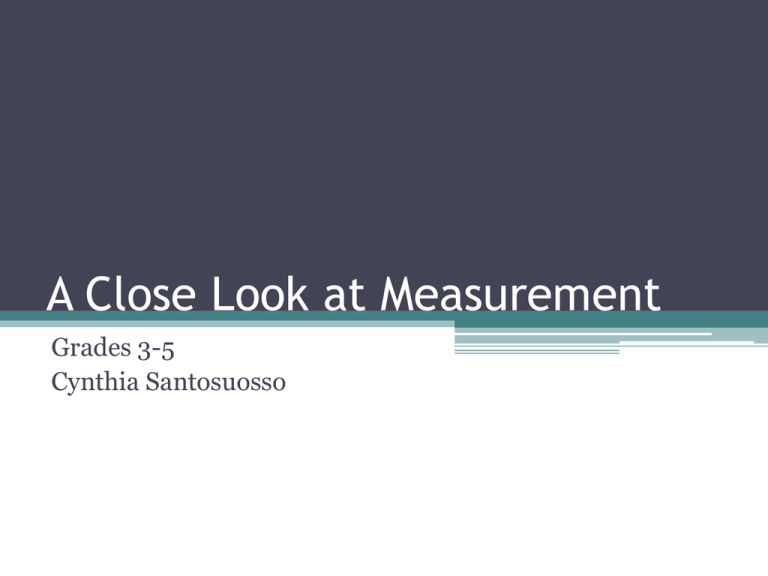
A Close Look at Measurement Grades 3-5 Cynthia Santosuosso Objectives 1. Understand the progression of measurement concepts in relation to the Common Core 2. Develop content knowledge about measurement 3. Collaborate with colleagues on teaching of measurement 4. Learn effective strategies to promote student learning of measurement Why Measurement? • “It bridges the two main areas of school mathematics-geometry and number.” ▫ NCTM, 2000 • “Measurement is justifiably seen as important, because it provides the main route to the application of mathematics to quantities in all daily life, science, and technology practice.” ▫ Ryan and Williams, 2007 Reflecting on Measurement Performance Only 24.36% answered correctly… NAEP, Grade 4, 2011 The square has a perimeter of 12 units. What is the area of the square? a. b. c. d. 6 square units 8 square units 9 square units 12 square units The Components of the Standard Measurement and Data Geometric Measurement Measuring Data Common Core Critical Area Grade 3: Students recognize area as an attribute of two-dimensional regions. They measure the area of a shape by finding the total number of same-size units of area required to cover the shape without gaps or overlaps, a square with sides of unit length being the standard unit for measuring area. Students understand that rectangular arrays can be decomposed into identical rows or into identical columns. By decomposing rectangles into rectangular arrays of squares, students connect area to multiplication, and justify using multiplication to determine the area of a rectangle. Common Core Critical Area Grade 5: Students recognize volume as an attribute of threedimensional space. They understand that volume can be measured by finding the total number of same-size units of volume required to fill the space without gaps or overlaps. They understand that a 1-unit by 1-unit by 1-unit cube is the standard unit for measuring volume. They select appropriate units, strategies, and tools for solving problems that involve estimating and measuring volume. They decompose three-dimensional shapes and find volumes of right rectangular prisms by viewing them as decomposed into layers of arrays of cubes. They measure necessary attributes of shapes in order to determine volumes to solve real world and mathematical problems. The Progressions Documents • Project designed by the University of Arizona • CCSS were originally built on the narrative progression of a topic across grade levels • University of Arizona is recreating these, because of the following benefits: • Explain why standards are sequenced in order • Identify cognitive difficulties for students • Provide pedagogical solutions • Explain difficult areas of mathematics in depth K-2 Progression of Measurement Kindergarten Describe and compare measurable attributes First Critical Area: Measure lengths indirectly and by iterating length units Second Critical Area: Measure and estimate lengths in standard units Relate addition and subtraction to length Task: Close Reading of Progressions 1. Closely read your section of the Progressions Document 2. Summarize the key points on chart paper 3. Share out Progressions Reflections… Complete the reflection sheet. Carousel Activity: Connections to the Mathematical Practices What opportunities do students have to engage in each mathematical practice while teaching your grade level measurement standards? What is measurement? Measurement is the process of quantifying the properties of an object by expressing them in terms of a standard unit. Measurements are made to answer such questions as, How heavy is this box? How tall is my daughter? How much chlorine is in this water? The Measurement Process Select an attribute of the item you wish to measure. Choose an appropriate unit of measurement for measuring that attribute. Determine the magnitude, or number of units needed. Turn and Talk: How can you measure this bucket? • Height • Depth • Diameter • Volume • Surface area • Weight Fundamental Components of Measurement Partitioning Conservation Transitivity Unit iteration Accumulation of distance Relation between number and measurement Partitioning • Dividing an object into same-size units. That this is not obvious to children becomes apparent when they are asked what the hash marks on a ruler mean. A child who does not understand partitioning of length sees the 3 on a standard ruler as a hash mark rather than as the end of a space that is divided into 3 equal-size units. Conservation The principle that an object maintains the same size and shape even if it is repositioned or divided in certain ways. The understanding that as an object moves, its length does not change. Transitivity When you can't compare two objects directly, you must compare them by means of a third object. The understanding that if the length of one object is equal to the length of a second object, which is equal to the length of a third object that cannot be directly compared with the first, the first and third objects are also the same length. Example: For example, to compare the length of a bookshelf in one room with the length of a desk in another room, you might cut a string that is the same length as the bookshelf. You can then compare the piece of string with the desk. If the string is the same length as the desk, then you know that the desk is the same length as the bookshelf. Unit Iteration Unit iteration is the repetition of a single unit along the length of an object. Children with little understanding of this concept often leave gaps between subsequent units or even overlap the units. Example: If you are measuring the length of a desk with straws, it is easy enough to lay out straws across the desk and then count them. But if only one straw is available, then you must iterate (repeat) the unit (straw). You first have to visualize the total length in terms of the single unit and then reposition the unit repeatedly. Accumulation of distance • When you iterate a unit along an object’s length and count the iterations, the number words convey the space covered by all units counted up to that point. five inches Relation between number and measurement • Many children fall back on their earlier counting experiences to interpret measuring tasks (for example, beginning with 1 rather than 0). Students who simply read a ruler procedurally have not related the meaning of the number to its measurement. Units Versus Numbers • “When measuring with a ruler of this type, children must deal directly with the fact that the length of an object is the number of units (spaces, not marks, on the ruler) between the beginning point and the end point” Why are these important? These are the building blocks of measurement! Without a solid foundation, students will not master area, angles, conversions, or volume. General Measurement Misconceptions • Measurement and measurement units are abstract concepts for children. Misconceptions About Length • Students have difficulty in determining the length of a line when the ruler is not aligned with the object starting at zero. This is because they count the marks/hashes on the ruler rather than the units. • Measurement is difficult for students because they confuse counting and measuring. • Children rarely understand that numbers are represented on the number line by lengths; instead, numbers are thought to be represented by the points they label. Misconceptions About Area • Children see area as calculation—a number separate from the real-world situation—rather than a measurement. • Children have difficulty in tiling a region with a unit of different shape than the region and they will not violate any boundary of the region while tiling. • Formula replaces the measurement with an instrument and impedes the understanding of measurement units. Misconceptions About Volume and Angle • When students have to find the volume of a space filled with unit cubes, they usually count only the cubes that are visible from a given angle. • Students think that the length of the rays constructing the angle has an effect on the measure of the angle. • They rarely understand that angle is a measure of rotation. Analysis of Student Misconceptions • Review the student misconceptions about measurement. • Identify the specific misconception. • Is there a specific area of measurement that the child is struggling with? Common Instructional Goals Familiarity with the units Ability to select an appropriate unit Knowledge of relationships between units Estimation v. Precision Both are extremely important in measurement! Estimation • Helps students focus on the attribute being measured and the measuring process. • When standard units are being measured, estimation helps develop familiarity with the unit. Ex: If you are measuring the height of a door in meters, you must first think about the size of a meter. • Forces students to check for reasonability! Strategies for teaching estimation in measurement • Develop and use benchmark measurements ▫ Ex: A paperclip is one inch; a sack of flour is 5 lbs • Use “chunking” Strategies for teaching estimation in measurement • Iterate a unit mentally or physically. Use your hands, feet, fingers, folds in paper to keep track of your measurement. Before you start measuring…. Precision • Measurement, by its very nature, is approximate. • The precision of the measuring device tells us how finely a particular measurement was made. • Measurements made using small units, such as square millimeters, are more precise than measurements made using larger units, such as square centimeters. Strategies for Teaching Precision • Have students specify unit of measure • Encourage students to make precise measurements • The accuracy of a measure is determined by how correctly a measurement has been made. Accuracy can be affected by the person making the measurement and/or by the measurement tool. Strategies for Teaching Length • Have students look at spaces, rather than hash marks. Students should count the units of measure. • Allow students to measure real-world objects, rather than only pictures on paper. • Create strong benchmark measurements for students to use as references for estimate and to check reasonability. Example: A small paperclip is about one inch long; I am about five feet tall. Strategies for Teaching Perimeter • “Unroll” the sides of a shape by drawing a line segment by tracing the length of each side of the figure. • If necessary, add the lengths on a ruler. • Provide hands-on experiences beyond calculating perimeter on paper. Strategies for Teaching Area • Arrays!!! • Unit covering/Tiling • Determining the area of a shape that is superimposed on a grid Strategies for Teaching Area/Perimeter • Pentominoes Strategies for Teaching Angles • Asking students to estimate the angle prior to measuring may help prevent them from misreading the protractor. Students can identify whether the angle is acute, obtuse or more or less than a right angle prior to measuring. Strategies for Teaching Angles • Provide students with opportunities to compare angles without measuring them. Strategies for Teaching Volume • Use models (cubes, boxes, stacks of books) to explain the formula • Make box models Transfer to EnVision • Review the following items: • Progressions reflection sheet • Common Misconceptions • Teaching strategies • Use sticky notes to mark up your upcoming EnVision measurement topics with important points that you want to remember when teaching these topics to students. It’s your turn! Try these measurement tasks and see what concepts and strategies you apply while problem solving. Measurement Task Problem of the Month: Surrounded and Covered Level D Level E Turn and Talk • What key ideas in measurement do these tasks promote? Sources • Oberdorf, Christine; Schultz-Ferrell, Karren. Math Misconceptions, PreK-Grade 5 Heinemann. Kindle Edition. 2010. • Bamberger, Honi and Christine Oberdorf. Activities to Undo Math Misconceptions. Portsmouth: Heinemann, 2010. • El Paso Collaborative for Academic Excellence. “Measurement: Student Misconceptions and Strategies for Teaching.” http://www.epcae.org/uploads/documents/Measuremen t_pck_SEP21.pdf • Annenberg Learner. “Fundamentals of Measurement.” http://www.learner.org/courses/learningmath/measurement /session2/index.html

